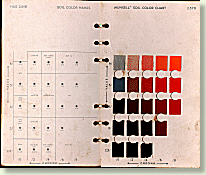
|
Soil Profiles & Stratigraphy
The succession of soil layers, from the surface to bedrock, is referred to as the soil profile. Stratigraphy deals with the origin (how did it get there?), the composition (what's in the soil?), and the succession (what came after what?) of soil layers. The sequence of layers is used to date the layers and the artifacts found within those layers. Stratigraphy is the method of uncovering history at an archaeological site. There are no written records at the DcRu4, so researchers investigate the layers of the site to reveal information.
Radiocarbon Dating (C14):
Radiocarbon dating or carbon 14 (C14), is one way that archaeologists determine the age of an artifact or soil layer. This method can date material from about 100 years to about 80,000 years ago. By measuring the amount of C14 atoms left in an organic object (like charcoal), it can show how long ago the soil layer was deposited.
Glossary terms: Radiocarbon Dating.
This is how it works: C14 is a radioactive isotope that forms in the earth's atmosphere. As C14 is spread around the earth, it mixes with C12 (a natural element found in all living things) and is absorbed by plants. We eat the plants and then C14 is absorbed in us. When we die, we cannot absorb any more C14. The C14 decays at a constant rate into Nitrogen 14 (N14). It takes 5730 years for half the amount of C14 to become N14. In other words, if we started with 1 gram of C14, then in 5730 years, that one gram would have decayed into 1/2 grams of C14 and so forth.
Glossary terms: Isotope.
There have been four C14 dates taken at Kosapsom, and these results have predicted DcRu4 to be aprroximately between 2400 and 1000 years old. Moreover, the artifacts collected at Kosapsom are estimated to be about 5000 years old. Artifacts found in situ can be associated with the soil layer they were in. If the C14 sample dates the soil layer, that date can be given to the artifacts as well.
Glossary terms: In situ.
The Munsell Colour Chart:
Another way of analyzing stratigraphy is colour coding. Munsell Color Charts aid the archaeologist in determining the colour of an archaeological soil or sediment. Determining each colour in a soil layer is important because archaeologists want to see the transition between layers. A difference in soil layer colour can show age, use of site, activities, and eating habits.

|

|
Munsell Colour Chart
What a page looks like
|
Each colour is given a code of letters and numbers so that they can be compared to other colours in the soil profile. The chart has sets of standardized colour chips arranged in rows on several pages. Researchers obtain a colour code by comparing the soil colour to one of the pages in the book. The purpose of this system is keep researchers from making arbitrary descriptions of colours.
|



